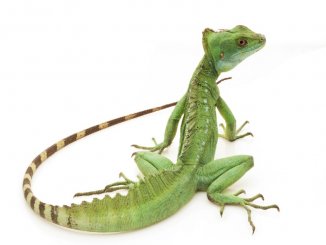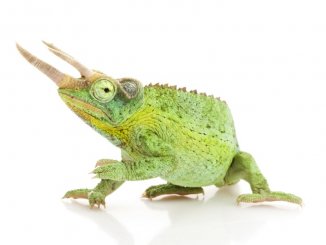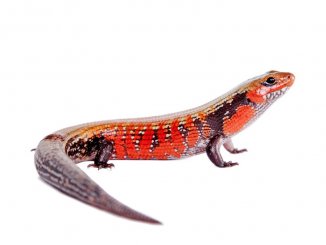The Mexican alligator lizard is bright green with defined scales over its body, short, robust limbs, and long claws. It has a prehensile tail that gives the lizard a unique and imposing appearance.
Mexican alligator lizards require a regulated set of variables to thrive in captivity. Beginner lizard enthusiasts often have a difficult time adjusting these variables to get the enclosure up and running, and because of this, keeping Mexican alligator lizards in captivity requires practice and patience but it’s worth the effort in the long run.
Mexican Alligator Lizard Overview
| Common name(s) | Green arboreal alligator lizard |
| Scientific name | Abronia graminea |
| Natural Habitat | Tropical rain forests along the Sierra Madre Oriental Mountain range in Mexico |
| Adult size | 6–2 Inches |
| Average Lifespan | 10 years |
| Diet | Insectivore |
| Housing | Vivarium |
| Experience | Expert |
Origin
The Mexican alligator lizard (Abronia graminea) is endemic to Mexico’s Sierra Madre Oriental mountain range. The species inhabits the tropical, subtropical, and pine-oak forests of Puebla, Oaxaca, and Veracruz, Mexico. The Mexican alligator lizard is arboreal and prefers to live in dense and cloud forest canopies.
Summer rains with a humid temperate climate ensure a healthy natural habitat for the Mexican alligator lizard. The lizard is an endangered species, and finding it in the wild is difficult.
Although the Mexican alligator lizard isn’t venomous, it does have a painful bite, so you should handle it with care.
Appearance and Behavior
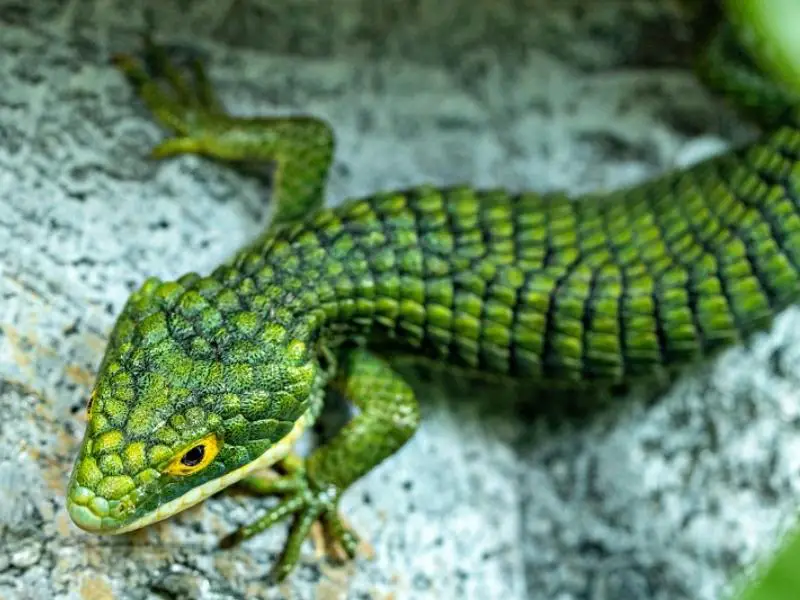
The Mexican alligator lizard’s colors range from bright green to yellow-green. Its beautiful dotted scales resemble large jagged plates that extend down the length of the lizard’s tail, giving it an imposing look. The Mexican alligator lizard also features a yellow lining around the eyes.
Juvenile Mexican alligator lizards appear tan and have black dots that allow camouflaging into tree barks. They have triangular heads and a long, prehensile tail, and their legs feature tiny claws that allow the lizards to grip on to branches and climb up trees.
Male alligator lizards are more colorful and larger than females. Males feature bright emerald green colors, while females have deeper colors with subtle green and yellow accents. The dorsal side of female Mexican alligator lizards is a reddish-orange color, while males have a green tint. Males are territorial and will defend their territory from other males.
Size and Lifespan
The average size of the Mexican alligator lizard is about 6–12 inches long. More than 50% of the lizard’s length is made up of its tail which can regrow if it breaks. The Mexican alligator lizard weighs an average of 0.7 ounces but can weigh over 5 ounces when fed well.
Mexican alligator lizards live an average of ten years in the wild. Captive lizards live longer than wild lizards due to better living conditions. The Mexican alligator lizard can live for 20 years in captivity when it’s given proper care.
Temperament
The Mexican alligator lizard is gentle and docile. The lizard can be aggressive when provoked and will bite if it feels threatened. The Mexican alligator lizard isn’t venomous, but it can leave a painful bite. It can also lose its tail to escape a predator’s grasp.
Male Mexican alligator lizards are territorial. Males will fight for their territory and can become aggressive if other males enter their range. Mexican alligator lizards don’t like being handled and will struggle to get away.
Housing Mexican Alligator Lizards
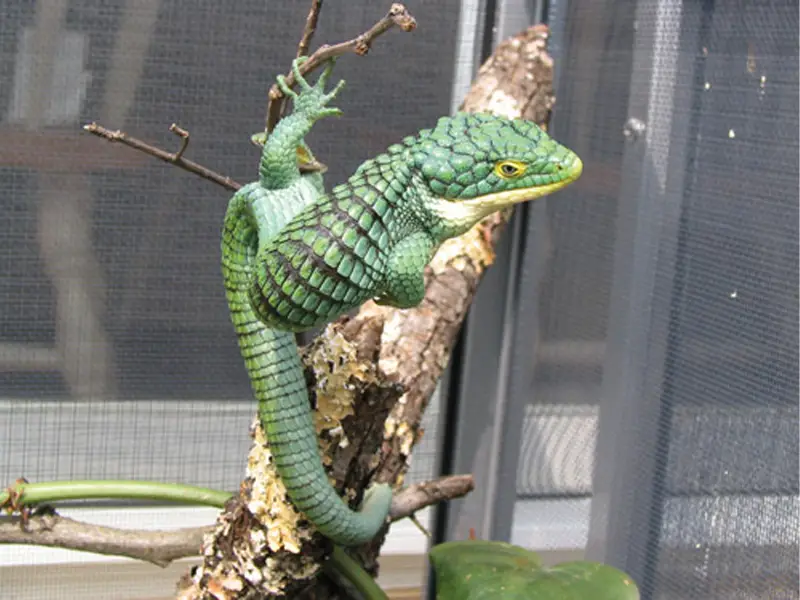
The ideal enclosure for Mexican alligator lizards is a self-cleaning vivarium or a custom cuboid vivarium built from plastic. The enclosure should be tall with ample ventilation. The height gives the Mexican alligator lizard room to move up and down, while the ventilation helps maintain an even temperature.
Mexican alligator lizards are arboreal creatures that live in dense, tall trees. The tropical nature of their environment means that lizard keepers should provide an enclosure that can mimic the forest canopy. Mexican alligator lizards are tropical and will do well in enclosures that provide a humid yet warm environment.
Enclosure Size
The ideal enclosure size of the Mexican alligator lizard is at least 30-inches tall, 20 inches wide, and 20 inches long. The height gives the lizard room to climb, while the width ensures adequate space to move around. The enclosure should have a small opening at the top and another larger one at the front for easy access.
Lighting
Mexican alligator lizards are diurnal, meaning they are the most active during the day. The lizards’ enclosure needs sunlight that makes up for about 10% of its lighting requirements. The enclosure should have a UV fluorescent tube that provides the right amount of lighting.
The fluorescent bulb should give off 7-10% UVB for about 12 hours every day to ensure a proper Vitamin D3 supplement. Natural sunlight provides the perfect amount of UVB that helps promote the vibrant emerald green Mexican alligator lizard color.
Temperature and Humidity
The ideal temperature for a Mexican alligator lizard is 75-80 °F. The temperature should drop to around 50-72 °F at night. A basking spot of approximately 78-82 °F is necessary for the lizard to metabolize calcium and warm its body.
High temperatures are dangerous for the Mexican alligator lizard. High temperatures can cause premature skin shedding, dehydration, and even death. A low-wattage light bulb above the basking spot will provide the necessary heat supplement.
The enclosure should have a constant humidity level ranging between 60-80%. Sufficient humidity ensures maximum hydration and prevents shedding problems. Using an automatic misting system or a full-spectrum humidifier helps maintain the humidity levels.
A heat thermometer and hygrometer are necessary to ensure proper temperature and humidity levels in the enclosure.
Substrate and Decoration
A layer of peat moss or cypress mulch serves as the best substrate for Mexican alligator lizards. The substrate helps retain humidity and absorbs odors. Other materials like leaf litter, coconut coir, organic potting soil, and Spanish moss are also excellent choices.
Avoid using sand, gravel, or crushed walnut shells because these substrates can cause impaction if ingested. The ideal rocks for Mexican alligator lizards are smooth rocks that don’t have sharp edges. Decorations such as cork bark, orchids, and bromeliads provide a natural look for the enclosure.
Tall tropical plants such as pothos and philodendrons that climb into the enclosure create a dense, natural habitat for Mexican alligator lizards. Natural and artificial vines work as excellent décor for the enclosure, and epiphytic plants such as orchids and bromeliads also help maintain humidity in the enclosure.
Cleaning
Cleaning the enclosure helps keep the habitat clean and comfortable for the Mexican alligator lizard. Remove the lizard gently before cleaning the enclosure. Spot clean the enclosure at least once a week to ensure there is no foul smell.
Remove all soiled substrate and disinfect the enclosure with a soap solution. Scrub the enclosure with a disinfectant to remove any bacteria, and rinse the enclosure thoroughly to ensure no chemical residues are left behind. Fill the enclosure with a fresh substrate to ensure it is ready for the Mexican alligator lizard’s return.
Mexican Alligator Lizard Care
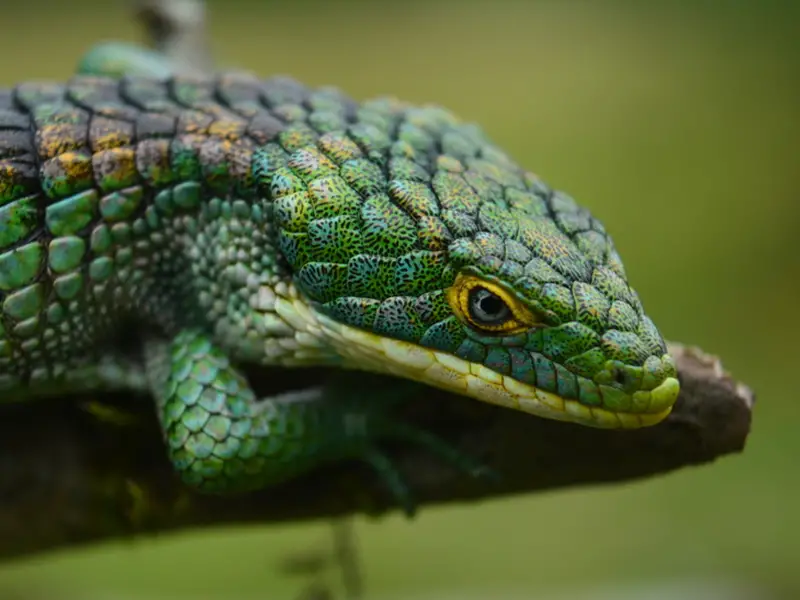
The most important care requirement for Mexican alligator lizards is providing the right humidity levels. High humidity is necessary for shedding and hydration purposes. Providing the right temperature and food ensures Mexican alligator lizards stay healthy and active.
Beginner Mexican alligator lizard keepers find it challenging to provide the lizards with the right care requirements. The lizard requires experience and knowledge about its psychology, biology, appearance, and behavior. Keeping Mexican alligator lizards means close monitoring and familiarity with their natural habitat.
Food and Water
Mexican alligator lizards are insectivorous. The lizards feed on crickets, cockroaches, super worms, silkworms, hornworms, butter worms, and locusts. Gut load the insects with nutrient-rich vegetables such as kale, zucchini, and spinach. Dust the insects with supplements like vitamin-D3 to provide an optimal meal for the Mexican alligator lizard.
Avoid feeding fireflies, elder bugs, and glowing bugs to Mexican alligator lizards because these bugs can be toxic. Lizards will drink water droplets that form on the leaves and walls of the enclosure after misting. Providing a shallow bowl of clean water ensures Mexican alligator lizards stay hydrated at all times.
Newborn Mexican alligator lizards feed on fruit flies and transition to small crickets as they grow. Juveniles and adults feed on large crickets, super worms, hornworms, butter worms, silkworms, and locusts. Feed newborns daily, juveniles at least every other day, and the adults three times each week.
Handling
The Mexican alligator lizard doesn’t fancy the human touch and will bite if provoked. The lizard can inflict a mild wound that may cause swelling or slight discomfort, but it isn’t poisonous. The Mexican alligator lizard is a delicate species and requires gentle handling.
Handle the Mexican alligator lizard by placing your hand underneath its belly and resting your other palm on top of the lizard’s body. Allow the lizard to move around your palm and curl its prehensile tail to curl around your fingers. Hold the lizard for a minute or two until it is comfortable.
Place the lizard back in the enclosure after handling to avoid stress. Stress can weaken the lizard, making it susceptible to illness, and affecting its behavior. Other causes of stress include the presence of a predator, a noisy environment, and dehydration.
Common Health Issues
Mexican alligator lizards are susceptible to several health issues that also affect other reptiles. The most common health issues include:
- Metabolic bone disease
- Respiratory infections
- Parasitic infections
Metabolic Bone Disease
The metabolic bone disease (MBD) is a benign bone disease that causes the Mexican alligator lizard to become soft and malformed. The disease results from poor metabolisms of calcium, vitamin D3, and phosphorus. MBD can result in physical deformities, lethargy, and paralysis. Other signs include limping, bowed legs, and decreased appetite.
Treating MBD in Mexican alligator lizards requires calcium, vitamin D3, and phosphorus supplements daily. Increasing the UVB and full-spectrum lighting will help the lizards metabolize calcium and vitamin D3. Proper husbandry and diet will help the lizards heal.
Respiratory Infections
Respiratory infections in Mexican alligator lizards result from temperature and humidity levels in the enclosure being either too high or too low. Other causes of respiratory infections include bacterial infections, parasites, and stress. Wheezing, bubbles in the mouth, loss of appetite, and lethargy are all signs of a respiratory infection.
Cures for respiratory infections in Mexican alligator lizards include maintaining the required temperature and humidity, proper husbandry, and disinfecting the enclosure. Treating the lizards with an antibiotic will help eliminate the infection, and preventing stress through proper handling, diet, and housing will have positive effects on the lizards.
Parasitic Infections
Mexican alligator lizards are also prone to parasitic infections caused by unhealthy dietary habits and poor husbandry. Parasites such as Cryptosporidiosis and C varanii are a common problem in captive Mexican alligator lizards.
Signs of parasitic infections include indigestion, loss of appetite, bloating, diarrhea, gassiness, and weakness.
Treating parasitic infections in Mexican alligator lizards involves anthelmintics, a drug that eliminates parasites in the body. You should disinfect the enclosure and offer a more varied diet to help the lizards recover.
Breeding
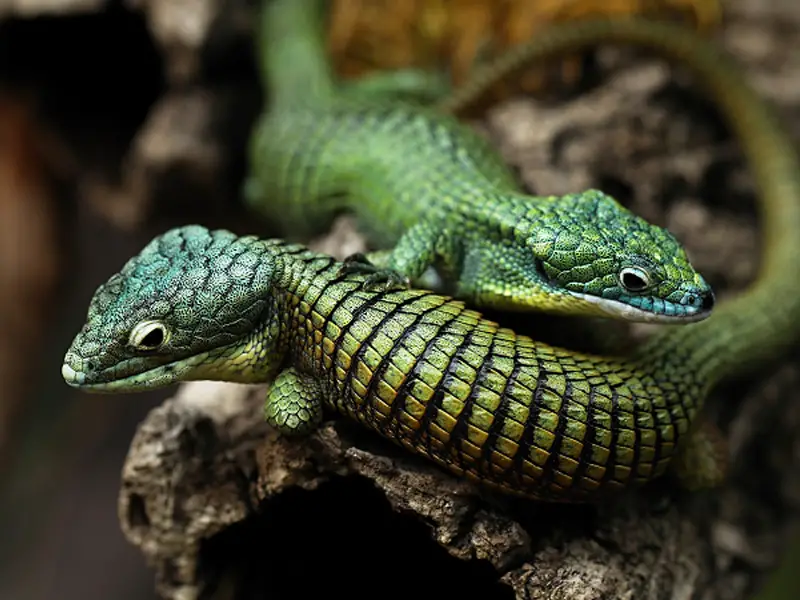
Breeding Mexican alligator lizards is a rewarding but demanding process. Lizards reproduce sexually and are sexually mature at two years of age. The breeding process happens during September, October, and December. Mexican alligator lizards are viviparous, meaning they give birth to live young.
Initiating the breeding process starts with ensuring that the lizards are healthy. Provide the lizards with cool temperatures, a clean habitat, and a varied diet. A 50-gallon tank placed outside in a shaded area with a loose, moist substrate works best for housing a breeding lizard.
The lizards require a temperature between 55°F and 75°F with humidity levels between 70% and 80% to induce breeding. Introduce the male and female Mexican alligator lizards and leave them alone for several weeks. The male lizard will only mate with a female that shows signs of interest. A ratio of one male to three females is good for probability.
The gestation period for Mexican alligator lizards is between 6-8 months. Females become visibly pregnant with swollen abdomens and will feature chalk sacs on either side of their jowls. The gravid females will build nests by digging shallow burrows in the substrate.
Feed the female Mexican alligator lizard protein-rich foods such as crickets one month before giving birth as they will stop feeding a month before birth. Hydrate the enclosure to ensure a cool and moist environment.
A basking spot with a temperature of 82°F ensures the development of healthy offspring. The female Mexican alligator lizard will give birth to 5–15 babies in a process that can take up to 24 hours.
Newborn Mexican alligator lizards will camouflage into the substrate after birth. The babies will start moving around after a few days to explore their surroundings. Feed baby Mexican alligator lizards, fruit flies, and pinhead crickets, and maintain the enclosure temperature at around 78°F and the humidity levels at 70-80%.
Exposure to temperatures exceeding 85°F can lead to death in newborn Mexican alligator lizards. Avoid keeping male and other adult Mexican alligator lizards with newborns. Other adult lizards can cannibalize or harass the babies. You should keep the newborns in groups of three or two until they reach sexual maturity at two years of age.
Choosing and Buying a Mexican Alligator Lizard
The price of a Mexican alligator lizard ranges between $100-$200 depending on the size, availability, and coloration of the lizard. Online pet stores, private breeders, and local pet stores usually have Mexican alligator lizards for sale. Reputable breeders who specialize in Mexican alligator lizards also offer them for sale.
The Mexican alligator lizard is protected under Mexican federal law. Export of the lizard is illegal, making the species difficult to find in other countries. Only captive-bred Mexican alligator lizards are available for purchase.
When choosing a Mexican alligator lizard, look for a healthy and alert animal with clear eyes and a nose. Watch out for a lizard with wounds or injuries and monitor it for signs of illness and parasites. Ensure the Mexican alligator lizard has sufficient humidity levels by misting it daily and line the enclosure with a substrate that retains moisture.

